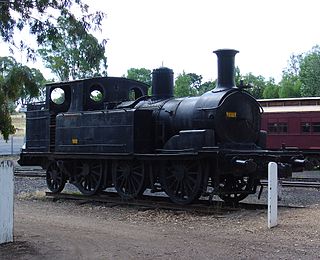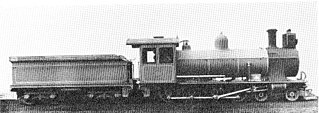
4-4-0 is a locomotive type with a classification that uses the Whyte notation for the classification of steam locomotives by wheel arrangement and represents the arrangement: four leading wheels on two axles, four powered and coupled driving wheels on two axles, and a lack of trailing wheels. Due to the large number of the type that were produced and used in the United States, the 4-4-0 is most commonly known as the American type, but the type subsequently also became popular in the United Kingdom, where large numbers were produced.

Under the Whyte notation for the classification of steam locomotives, 0-4-2 represents the wheel arrangement with no leading wheels, four powered and coupled driving wheels on two axles and two trailing wheels on one axle. While the first locomotives of this wheel arrangement were tender engines, the configuration was later often used for tank engines, which is noted by adding letter suffixes to the configuration, such as 0-4-2T for a conventional side-tank locomotive, 0-4-2ST for a saddle-tank locomotive, 0-4-2WT for a well-tank locomotive and 0-4-2RT for a rack-equipped tank locomotive. The arrangement is sometimes known as Olomana after a Hawaiian 0-4-2 locomotive of 1883.

The GWR 5600 Class is a class of 0-6-2T steam locomotive built between 1924 and 1928. They were designed by C.B Collett for the Great Western Railway (GWR), and were introduced into traffic in 1924. After the 1923 grouping, Swindon inherited a large and variable collection of locomotives from historic Welsh railway companies, which did not fit into their standardisation programme. GWR boiler inspectors arrived en masse and either condemned the original locomotives or had them rebuilt. The systematic destruction of many examples of locomotives, most still in serviceable condition, followed, but various were worked alongside 5600 Class.
The DD class (later reclassified into D1, D2 and D3 subclasses) was a passenger and mixed traffic steam locomotive that ran on Victorian Railways from 1902 to 1974. Originally introduced on mainline express passenger services, they were quickly superseded by the much larger A2 class and were relegated to secondary and branch line passenger and goods service, where they gave excellent service for the next fifty years. The DD design was adapted into a 4-6-2T tank locomotive for suburban passenger use, the DDE (later D4) class. They were the most numerous locomotive class on the VR, with a total of 261 DD and 58 locomotives built.
The Phoenix Foundry was a company that built steam locomotives and other industrial machinery in the city of Ballarat, Victoria, Australia. Over 30 years they built 352 locomotives for the Victorian Railways, of 38 different designs.

The mainline passenger locomotives, later classified as B class, ran on the Victorian Railways (VR) between 1862 and 1917. They used a 2-4-0 wheel arrangement, which provided greater traction on the new, more heavily graded Geelong–Ballarat railway and the Melbourne-Bendigo-Echuca railway, as opposed to the 2-2-2 arrangement previously selected for the relatively level Geelong line. The B class locomotives are regarded as the first mainline VR motive power, and were highly successful in passenger operations.
The Victorian Railways V Class is a steam locomotive, used on the Victorian Railways in the period 1900-1930.

The Victorian Railways Y class was a class of 0-6-0 steam locomotives.

The pattern suburban E class tank loco was built by Kitson & Co of Leeds, England, in 1888 and was a typical British tank engine of the 2-4-2 wheel arrangement. The original loco, named "Tasmania" by the builder, was displayed in the Centennial International Exhibition in the Melbourne Exhibition Buildings in 1888.

The Victorian Railways F class locomotives were built in 1874, 1876–77 and 1879–80 by Beyer, Peacock & Company and the Phoenix Foundry in Ballarat as 2-4-0 tender locomotives. They were normally used on passenger trains. In 1911 the Victorian Railways decided to convert seven of them into "motor" locomotives. These became 2-4-2 tanks. They kept their numbers 172–184. The unrebuilt tender engines were taken off register between 1916 and 1922. The "motors" were taken off register between 1920 and 1929. One of the class, number 176, survived after being sold to Sunshine Harvester Works in 1920, where it stayed there shunting until 1961. It was then donated to the Newport Railway Museum in North Williamstown and is now the oldest surviving Victorian Railway locomotive, being built in 1880.

The South African Railways Class GH 4-6-2+2-6-4 of 1928 was an articulated steam locomotive.

The South African type ZC tender was a steam locomotive tender from the pre-Union era in the Cape of Good Hope.

South African steam locomotive tenders were classified by means of type letters and sometimes numbers, while locomotive specifications included a list of permissible tenders which could be used with each engine class.

The South African type XF tender was a steam locomotive tender from the pre-Union era in Transvaal.

The South African type MP1 tender was a steam locomotive tender.

The South African type XE1 tender was a steam locomotive tender from the pre-Union era in the Cape of Good Hope.

The South African type TL tender was a steam locomotive tender.

The South African type XC1 tender was a steam locomotive tender from the pre-Union era in the Cape of Good Hope.

The South African type XE tender was a steam locomotive tender.

The South African type MR tender was a steam locomotive tender.


















